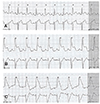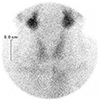Abstract
We report the case of a middle aged woman who was previously diagnosed with hypertension. She had been drinking a kelp concentrate solution daily for her hypertension instead of taking the prescribed medicine due to her personal beliefs about the kelp solution. As a consequence, she experienced vasospastic angina complicated by myocardial infarction and cardiogenic syncope resulting from iatrogenic thyrotoxicosis.
Complementary medicine is widely used by the general population. However, there is still a lack of evidence regarding their efficacy and safety. This case shows that inadequate use of complementary medicine could have no effect and may even be harmful. In patients with chronic diseases such as hypertension, self-care in the form of life style modification, home blood pressure monitoring and medial adherence are important for disease management.
As the general interest in healthcare has increased, the use of complementary medicine (CM) has also increased.1)2) One article reported that 44.8% of antihypertensive patients confirmed that they were taking CM through questionnaires.2) The authors also reported that the use of CM was significantly associated with reduced adherence to antihypertensive medication in females.
Good adherence to medical therapy is especially important for patients with hypertension, which requires lifelong therapy and medical care. It is well known that nonadherence to treatment recommendations including prescribed medications in patients with cardiovascular risk factors is a major contributor to treatment failure and poor outcomes.2)3)
Here we introduce a case of iatrogenic thyrotoxicosis resulting in severe coronary vasospasm and cardiogenic syncope in a 50-year-old woman. She was diagnosed with hypertension about 20 years ago and refused to receive medical treatment or regular checkups. She was taking a self-made kelp concentrated solution daily to control her blood pressure (BP) for the last 10 months.
A 50-year-old female visited the emergency department due to squeezing chest pain that had become aggravated in frequency and severity over 2 weeks. She was diagnosed with hypertension 20 years ago. However, she had not received medical treatment and had been taking a self-made kelp concentrate daily for her high blood pressure during the last 10 months. She had no cardiovascular risk factors besides hypertension. Her initial electrocardiogram (EKG) presented sinus tachycardia at 104/min without significant ST deviations but cardiac biomarkers were elevated as follows: creatine kinase-MB fraction 16.5 ng/mL (normal, <5.0) and troponin T 0.202 ng/mL (normal, <0.01) with normal range creatine kinase 128 IU/L (reference range, 55-245). Her transthoracic echocardiography showed preserved left ventricular (LV) systolic function at 66% of the ejection fraction without regional wall motion abnormality and normal LV mass index but increased relative wall thickness as 0.48. On the day of admission, she complained of nausea and fainted in a restroom. Her brain computed tomography (CT) failed to show any abnormality. However, EKG revealed ST segment elevation in the leads of II, III, aVF and reverse V3-6, which were normalized after nitroglycerin administration. The next morning, a second episode of syncope with eyeball deviation was witnessed by her son and EKG telemetry showed ST elevations and QRS widening at that time (Fig. 1). Her coronary angiography (CAG) demonstrated diffuse significant luminal narrowing of all left coronary arteries including the left main (Fig. 2) and mid right coronary arteries (Fig. 3), which was resolved by intracoronary nitroglycerin injections. Her thyroid function test result was significant, with increased total triiodothyronine at 271.4 ng/dL (reference arrange, 58-159), free thyroxine at 7.09 ng/dL (reference range, 0.7-1.48) and decreased thyroid stimulating hormone at 0.001 µIU/mL (reference range 0.35-4.94). A thyroid scan showed decreased 24-h iodine uptake at 0.31% and thyrotropin binding inhibiting immunoglobulins level was <0.30 (Fig. 4). These findings were compatible with acute thyroiditis combined with thyrotoxicosis. She was diagnosed with iatrogenic thyroiditis related to the consumption of excess iodine from kelp concentrate and coronary vasospasm induced by thyrotoxicosis. We did not perform coronary angioplasty for her minimal coronary artery obstructive lesions and started medical treatment with aspirin, nicorandil, nifedipine, and isosorbide dinitrate. After discontinuing the kelp solution, her thyroid function was restored to normal without thyroid medication. She has been followed up in the outpatient clinic without a cardiac episode for 2 years since.
About half of the hypertensive patients in outpatient clinics reported using CM alongside prescribed antihypertensive drugs.2) There are various types of CMs, and many of them lack evidence of efficacy and safety to date. Although several CMs including garlic and hibiscus have shown an antihypertensive effect in meta-analysis or randomized clinical trials, some CMs may have harmful effects.2)4)
Kelp, one of the sources of excess iodine, is well-known to cause thyroid dysfunction.5) Thyrotoxicosis resulting from kelp consumption has been reported including two women diagnosed with thyrotoxicosis after taking tea containing kelp as alternative medicine and dietary supplements containing kelp, respectively.6)7) The authors assumed that the iodine intake for one of the two women was 2400 µg/day including dietary sources and 580-990 µg/day for the other. The iodine content of kelp broths are quite variable and a Japanese study reported that twenty supermarket soups with kelp or kelp broth contained 165 to 7750 µg iodine per serving (about 0.25 L).8) There is lack of published data regarding the iodine content of Korean kelp broth; the Korean ministry of Food and Drug Safety reported that 1g of kelp contained about 1790 µg iodine. The average iodine content of kelp solution is estimated to be 1800-2500 µg per 100 mL. If a patient takes about 250 mL of kelp solution per day, her daily iodine intake has been estimated to be 5000-6750 µg/day including 500 µg of dietary iodine intake. Our patient took more than twice the dose of iodine compared to previous reports.
Thyrotoxicosis induced coronary vasospasm is uncommon but has been reported continuously since the first case report in 1979.9)10)11) Most of the cases predominantly involved females, Asians, and were related with Graves' disease.10)12) There was also one case report of myocardial infarction and cardiogenic shock following excess exogenous thyroid hormone replacement.13) However, this is the first reported dietary supplement induced thyrotoxicosis related to coronary vasospasm, myocardial infarction and cardiogenic syncope to our knowledge.
The typical presentation of thyrotoxicosis is weight loss, tremor and cardiac arrhythmia. Previous reports indicated that thyrotoxicosis induced variant angina did not show classic symptoms of hyperthyroidism at their initial presentations and the treatment of choice is to achieve a euthyroid state.10)11) To make an exact diagnosis, clinical suspicion about thyrotoxicosis is an important first step and careful history documentation is essential.
Generally, the thyroid hormone is known to have a role in vasodilation and the reduction of systemic vascular resistance.14) However, there have been conflicting reports on the effect of hyperthyroidism on endothelial function.15)16) Napoli et al.17) suggested that vasodilation from excessive endothelial nitric oxide (NO) production and vasoconstriction resulting from an active response to norepinephrine were potentiated in hyperthyroidism. The basic mechanisms of how altered endothelial function and individual susceptibility lead to variant angina in hyperthyroidism have not been well established. A report18) on thyroxine emphasized that hyperthyroid patients had a higher level of L-arginine, which was synthesized to NO, and had a much higher level of asymmetric dimethylarginine (ADMA), which suppressed NO synthesis, than hypothyroid or euthyroid patients. Hence, the ratios of L-arginine to ADMA and NO levels were decreased in hyperthyroidism. They measured NO as nitrite plus nitrate (NOx) and showed that free thyroxine levels were directly correlated with ADMA and diversely correlated with NOx. From this result, the high level of free thyroxine may be one of the causes of coronary vasospasm and myocardial infarction in the present patient.
The use of CM was significantly associated with reduced adherence to antihypertensive medication in females.2) Even though there is a difference between racial/ethnic groups and also a relation to cultural and social factors, the major reason for taking complementary medicine in women is a personal desire for a natural approach to treat the disease rather than dissatisfaction with conventional medicine as well as social influence including informal networks of family and friends.1) Hence, it is important to understand the reasons for using CM in patients with chronic diseases and to provide accurate information and education on the disease to prevent harmful effects and improve outcomes.
This case shows that inadequate use and a misplaced belief in CM is not only ineffective but may induce a fatal outcome. She already had minimal coronary artery obstructive disease and increased relative wall thickness in echocardiography due to the uncontrolled hypertension and she developed life threatening coronary vasospasm from the CM. Physicians responsible for hypertensive patients need to be aware of the patients' behavior and provide them with the correct motivation to live a healthy lifestyle and improve their medication adherence.2)19)20)
Figures and Tables
 | Fig. 1EKG telemetry showing serial changes in the EKG from normal (A), ST-segment elevation, (B) to QRS widening (C), as the patient fainted. EKG: electrocardiogram. |
 | Fig. 2Coronary angiography showing diffuse significant luminal narrowing of the left anterior descending artery (A) which was relived after intracoronary nitroglycerine injection (B) but minimal atherosclerotic lesions still remained. |
References
1. Chao MT, Wade C, Kronenberg F, Kalmuss D, Cushman LF. Women's reasons for complementary and alternative medicine use: racial/ethnic differences. J Altern Complement Med. 2006; 12:719–722.
2. Gohar F, Greenfield SM, Beevers DG, Lip GY, Jolly K. Self-care and adherence to medication: a survey in the hypertension outpatient clinic. BMC Complement Altern Med. 2008; 8:4.
3. De Geest S, Sabate E. Adherence to long-term therapies: evidence for action. Eur J Cardiovasc Nurs. 2003; 2:323.
4. Ernst E. Complementary/alternative medicine for hypertension: a mini-review. Wien Med Wochenschr. 2005; 155:386–391.
5. Leung AM, Braverman LE. Consequences of excess iodine. Nat Rev Endocrinol. 2014; 10:136–142.
6. Eliason BC. Transient hyperthyroidism in a patient taking dietary supplements containing kelp. J Am Board Fam Pract. 1998; 11:478–480.
7. Mussig K, Thamer C, Bares R, Lipp HP, Haring HU, Gallwitz B. Iodine-induced thyrotoxicosis after ingestion of kelp-containing tea. J Gen Intern Med. 2006; 21:C11–C14.
8. Zava TT, Zava DT. Assessment of Japanese iodine intake based on seaweed consumption in Japan: A literature-based analysis. Thyroid Res. 2011; 4:14.
9. Featherstone HJ, Stewart DK. Angina in thyrotoxicosis. Thyroid-related coronary artery spasm. Arch Intern Med. 1983; 143:554–555.
10. Al Jaber J, Haque S, Noor H, Ibrahim B, Al Suwaidi J. Thyrotoxicosis and coronary artery spasm: case report and review of the literature. Angiology. 2010; 61:807–812.
11. Wei JY, Genecin A, Greene HL, Achuff SC. Coronary spasm with ventricular fibrillation during thyrotoxicosis: response to attaining euthyroid state. Am J Cardiol. 1979; 43:335–339.
12. Choi YH, Chung JH, Bae SW, et al. Severe coronary artery spasm can be associated with hyperthyroidism. Coron Artery Dis. 2005; 16:135–139.
13. Bergeron GA, Goldsmith R, Schiller NB. Myocardial infarction, severe reversible ischemia, and shock following excess thyroid administration in a woman with normal coronary arteries. Arch Intern Med. 1988; 148:1450–1453.
14. Fazio S, Palmieri EA, Lombardi G, Biondi B. Effects of thyroid hormone on the cardiovascular system. Recent Prog Horm Res. 2004; 59:31–50.
15. Napoli R, Guardasole V, Angelini V, et al. Acute effects of triiodothyronine on endothelial function in human subjects. J Clin Endocrinol Metab. 2007; 92:250–254.
16. Fukuyama K, Ichiki T, Takeda K, et al. Downregulation of vascular angiotensin II type 1 receptor by thyroid hormone. Hypertension. 2003; 41:598–603.
17. Napoli R, Biondi B, Guardasole V, et al. Impact of hyperthyroidism and its correction on vascular reactivity in humans. Circulation. 2001; 104:3076–3080.
18. Hermenegildo C, Medina P, Peiro M, et al. Plasma concentration of asymmetric dimethylarginine, an endogenous inhibitor of nitric oxide synthase, is elevated in hyperthyroid patients. J Clin Endocrinol Metab. 2002; 87:5636–5640.
19. Finset A, Gerin W. How can we promote medication adherence and lifestyle changes in hypertensive patients? Patient Educ Couns. 2008; 72:1–2.
20. Bell RA, Kravitz RL. Physician counseling for hypertension: What do doctors really do? Patient Educ Couns. 2008; 72:115–121.




 PDF
PDF ePub
ePub Citation
Citation Print
Print




 XML Download
XML Download